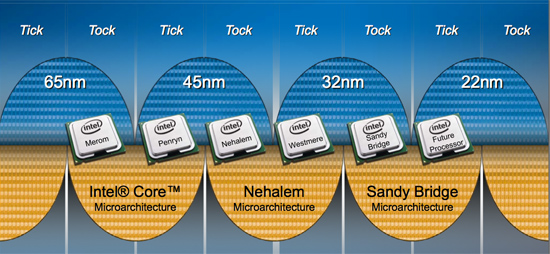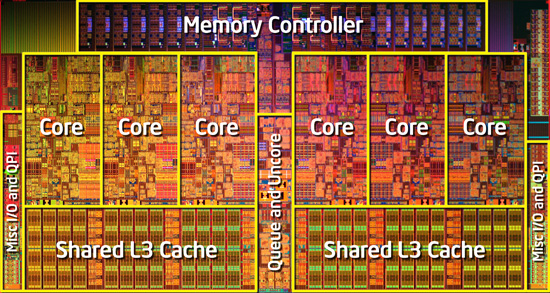Apple Mac Pro (Mid 2010) Review
by Anand Lal Shimpi on October 6, 2010 9:26 PM ESTCPU Options
Intel continues to sell both 45nm Nehalem based Xeons as well as 32nm Westmere models. As a result, Apple offers both in its new Mac Pro lineup. If you aren't familiar with the two architectures have a look here and here.

The entry level single-socket quad-core uses a Nehalem Xeon, the rest of the lineup (all six-core and two-socket quad-core) uses Westmere based Xeons. As a result, the single-socket quad-core Mac Pro has an 8MB L3 cache while the rest have 12MB L3 caches (as well as the other Westmere enhancements). Unfortunately Apple is still slow to adopt AES-NI so one of the major Westmere features goes unused in OS X.

There are other differences between platforms. The quad-core options (Nehalem and Westmere) all support DDR3-1066, only the six-core CPUs support DDR3-1333.
The added cache should help performance but the bigger improvement will be in power consumption. You'll be able to get more cores at the same power levels as the Nehalem Mac Pro, or the same number of cores at lower power.
The single socket systems use a physically different CPU/memory daughterboard, so there’s no hope for those wanting to simply stick in another CPU down the road.
Turbo is still alive and well but the frequency gains aren’t all that great. The single socket quad-core runs at 2.8GHz and can turbo up to 3.06GHz, while the eight-core configuration starts at 2.40GHz and can only turbo up to 2.66GHz.
Roadmap
With the arrival of Sandy Bridge imminent, you might ask - why buy a Mac Pro today? And I might answer, Sandy Bridge isn't imminent for everybody.
In 2008 Intel introduced the Nehalem based Xeon and Core i7 CPUs. This architecture was the basis for the original Mac Pro. From 2008 through the end of 2009, Nehalem was not replaced at the top of the processor stack. There were more affordable derivatives (Lynnfield), but nothing usurped Nehalem's role as the top dog. Having just been updated last year, Lynnfield skipped an upgrade in 2010 and instead we saw Nehalem's replacement (Westmere, in the new Mac Pro) and new dual-core offerings (in the new MacBook/MacBook Pro). When Sandy Bridge arrives in early 2011, it won't replace any 6-core offerings in the product stack. You'll see some very competitive quad-core CPUs, but if you need more threads you'll have to wait.

How long? Probably until Q4 2011 at the absolute earliest for 8-core Sandy Bridge based parts. Apple could update the entry level quad-core Mac Pro to Sandy Bridge before the middle of next year however.










84 Comments
View All Comments
mattgmann - Thursday, October 7, 2010 - link
I understand including a nice case, as the mac case is quality. But you're right, $250 is a bit steep. There are plenty of less expensive cases that are just as nice, and some real budget cases that would be serviceable.hellotyler - Thursday, October 7, 2010 - link
If I had the money, I'd buy one of these in a second. Apple rules. In today's world though, budget is important and PC beats out Apple heartily on the mid-powered PC market. I own both Mac and Pc (side by side, my two babies) and I love them both dearly. If I had to choose a brand new super powered computer though, I'd have to go with the Mac because of the OS.noiseunit - Thursday, October 7, 2010 - link
Maybe I'm missing something here but a quick search on newegg showed a $700 difference in the price of the graphics cards, maybe thats why the dell is so expensive?Stokestack - Tuesday, October 12, 2010 - link
The Mac IS a PC. If you mean a Windows system, then say that.ViperV990 - Thursday, October 7, 2010 - link
Didn't see it mentioned in the article, so I'm assuming no, but I want to double-check: Does the Mac Pro support 3x1 Eyefinity setup?Also, it's a shame that they're not offering the Eyefinity 5 or 6 models as an option.
Porksmuggler - Thursday, October 7, 2010 - link
Really appreciate the honest comparison to the custom built, but the Dell T5500 isn't exactly comparable. It's easy to say "other than the graphics card" but seriously:Apple's ATI Radeon HD 5770 1GB - $249 from Apple or $125 from Newegg
Dell's ATI FirePro V8700 1GB - $860 from Newegg
Anand Lal Shimpi - Thursday, October 7, 2010 - link
It's a tough comparison to make if you really want to dive into it. The FirePro price premium is due largely to the driver work and it's tough to tell what equivalent driver work (if any) Apple has done in OS X. Either way, it does change things quite a bit and I've updated the text to reflect that there is an Apple tax that's just hidden by the GPU cost differential.Thanks for the comment :)
Take care,
Anand
Porksmuggler - Thursday, October 7, 2010 - link
Thanks for the update, it truly is a tough comparison.I think an even greater concern with both the Dell and Apple tax is that both are using what might be considered as "commodity components"; Apple certainly would be using Foxconn, and I do not know of Dell's core supplier. The point being, these components do not have the same reputation of quality and performance as those used in the custom built.
The extent of the tax goes even further...
Sunburn74 - Thursday, October 7, 2010 - link
Not sure how you managed to reach the $324 number you published in the edit in the article. The cheapest fireprov8700 I can find costs 600 flat (ebay buy it now). The difference is at least $500 once you deduct the street costs of the packaged gpu.jecs - Thursday, October 7, 2010 - link
To me the "why a Mac Pro" is I have been afraid to build myself a solid dual socket PC workstation class machine for Pro 3D modeling, rendering and compositing with Maya and Final Cut Pro. But now I am very used to some pro Apple and none Apple software and happy. So in my case my current 2.8 octacore has been very, very reliable. For graphic design I agree it gets more difficult every time to justify a dual socket machine like a Mac Pro. Why 8-12 core for illustrator or even Photoshop?, Get the fastest quadcore PC for this. But also is a matter of personal preference.The Mac Pro is not the fastest machine out there but not either the most expensive or exotic hardware as there are usually faster PC hardware and more specific software options and features. But, if you like me are using specific multithreaded Pro software with decent performance and like OSX, then the Mac Pro is very solid. No Mac Pro has died on me yet, they are easy to upgrade for the most common features, work very well out of the box, is reliable, offers dual socket options and no Apple tax on comparable Dell or similar workstations.
On the other hand, even I use the Mac Pro all day long I builded a SFF quad core PC and this is the machine I am going to upgrade this year. The PC is "my back up" machine but the one that goes outside with me when I need performance, and also one very useful rendering machine.
By the way Anand, very good article! I enjoyed very much reading through the lines, not defensive at all, not too long and I learned on some features and coments. At least to my experience as a Mac Pro user from the beginning and even from the days of the G5s.